- the house of nature, a slightly different museum -
- information about Haus der Natur - Cismar,
its collections and its projects -
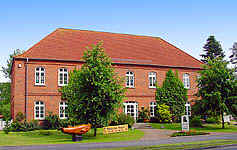
| Haus der Natur - Cismar - the house of nature, a slightly different museum - - information about Haus der Natur - Cismar, |
 |
about our scientific journal Schriften zur Malakozoologie
(with a complete index of Schr. Malakozool.), papers published by Haus der Natur (in German language), conservation of molluscs in Germany (in German language), a list of molluscs inhabiting the Baltic Sea (in German language), the
German Malacological Society (in German language), the Verein zur Förderung der Naturkunde in Cismar e.V. (in German
language), malacological addresses, short infos
on museums in the vicinity of Cismar (in German language), and much more.
photo gallery
snail
mail? Who's who in the "Haus der Natur - Cismar" (in German
language)
| Sie können Informationen in
deutscher Sprache wählen. |
No photographs may be reproduced
without |
| The museum in the village | page written by Dr. Vollrath Wiese, Haus der Natur Cismar |
Important museums of natural history are usually located in the largest towns. Finding a remarkable museum in a small village of 400 inhabitants is something new. A journey to Cismar (northern Germany, near Groemitz, 5 km from the shores of the Baltic Sea) will show you how this project was realized.
Where to go?
Cismar is located in the vicinity of Groemitz/Baltic Sea, halfway between the town of Luebeck and the island of Fehmarn in Schleswig-Holstein, the northernmost province of Germany, northeast of Hamburg.
The easiest way to go to Cismar is to follow the highway A1 from Hamburg northward past Luebeck. About 50 km northeast of Luebeck there is a highway-exit to Cismar, including a sign for „Kloster Cismar" (the ancient monastery of Cismar with its famous altar, which can be visited). You can follow the road to „Kloster Cismar". The Haus der Natur - Cismar is located on the road B 501 in the centre of the village Cismar 150 m from the monastery.
| The „Haus der Natur - Cismar" (= house of nature,
Cismar/Germany) is a privately owned nature museum, which displays some ten thousand
objects in an area of 500 m². The museum has been open to the public since 1979. centre: Spider-conchs of the genus Lambis from Indopacific |
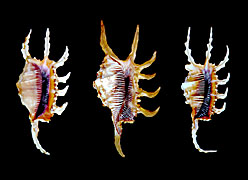 right: in the exhibit - the Nautilus-showcase |
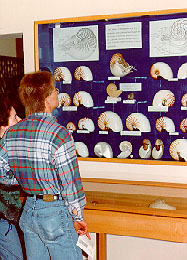 |
below: stuffed "waxwing" (Bombycilla garrulus) in the exhibit
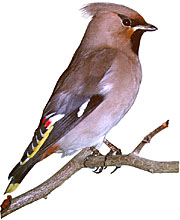 |
You can see native and exotic minerals, fossils, stuffed birds and mammals, crabs, corals as well as a butterfly collection and many unusual insects. The outstanding part of the museum is its shell collection, containing many beautiful and rare specimens. With more than 4,000 molluscan species it is the largest exhibition of shells in Germany. The collection represents a clear survey of this second largest phylum of animals in its almost endless variety. Shells of every shape and colour, from the size of a grain of sand to one meter in diameter can be seen. Many of the shells in the collection are genuine rarities, some are unique in Europe. |
Due to the limited exhibition space, the Haus der Natur is only able to display a small part of its collections. In addition to its normal exhibits the Haus der Natur contains an extensive collection of molluscs used only for scientific research and special exhibits. This collection is continuously being enlarged. Numbering in the millions (120,000 lots) the collection of shells of the Haus der Natur is one of the largest private collections in the world.
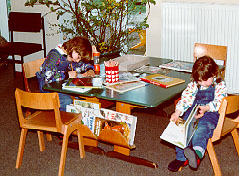 children's table in the museum |
During the year you can see several special exhibits in the Haus der
Natur - Cismar. A classroom for environmental education, which is also used for lectures
and scientific workshops rounds off the museum's offerings. Environmental education is
also propagated by the Verein zur Förderung der Naturkunde in
Cismar e.V. There are extensive materials for teaching and learning available to the
visitors in the museum. In its personal and friendly atmosphere the museum offers a vast amount of intelligible information and still retains its scientific integrity. The staff will always try to answer your questions about the natural sciences. |
You can find the Haus der Natur - Cismar in the centre of the village Cismar near the ancient monastery. There is a designated footpath 150 m in length leading from the monastery to the museum.
The museum is open throughout the year. Up to 2012 it has had more than 600,000 visitors.
Open hours: Daily, 10.00 - 19.00 hrs. (Please make an appointment for larger groups.)
Address: Haus
der Natur - Cismar, (Dr. Vollrath Wiese),
Baederstrasse 26, D-23743 Groemitz-Cismar,
Phone & Fax ..49 4366 1288, e-mail: info@hausdernatur.de
www.hausdernatur.de
Of course the quality of the museum cannot be measured merely by visiting its exhibits. A lot of molluscan research goes on behind the scenes here at our museum.
 |
Conservation of molluscs Concerning the protected species the Haus der Natur - Cismar is an official advisor for the Germany's custom's offices and conservation authorities on behalf of German laws on nature protection and CITES. A brochure containing an illustrated list of molluscan species protected by German laws is published by Haus der Natur - Cismar. left: Vertigo moulinsiana, a highly specialized species of the wetlands, which is protected by the european Fauna and Flora Habitats Directive FFH. |
| Survey of molluscs Dr. Vollrath Wiese is managing a mapping project on land- and freshwater molluscs in the northernmost province of Germany, Schleswig-Holstein. The project resulted in a bibliography, an atlas including maps and ecological information for all species and a red data sheet on the land- and freshwater molluscs of Schleswig-Holstein. |
above: Testacella haliotidea was discoverd as living in Schleswig-Holstein during the mapping project, it is a subterranean species which feeds on earthworms |
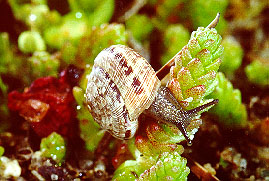 Candidula intersecta, a common species of dry habitats, typical representative of the collection of local species |
Collection of local molluscs As a result of the mapping project on land- and freshwater molluscs of Schleswig-Holstein, the acquisition of the collection of Dr. Siegfried G. A. Jaeckel (1907-1986, the most important local collection of nonmarine molluscs), the discovery of voucher material collected during research work for ecological purposes and field-projects carried out by the museum’s own malacologists the „Haus der Natur" has, besides its international collection, become a very inportant repository with its regional collection containing some ten thousand lots of molluscs. Thus the „Haus der Natur" offers the exceptional possibility of studying the extensive mapping database together with the corresponding documentation material. Concerning ecological studies we emphasize the special importance of permanent documentation of voucher material in an institution open to the public. |
Scientific documentation collection
The scientific collection contains about 120.000 lots of molluscs. This is medium-sized in relation to other international museum's collections. This is also true for the 600 lots of types and voucher specimens. More than half of the scientific collection has been computerized, as well as much of the historical material.
Publications and scientific contacts
Because of its activities the Haus der Natur - Cismar is becoming an international centre of malacology. Volume 25 of the scientific journal „Schriften zur Malakozoologie aus dem Haus der Natur - Cismar" is published. Since the start of the journal in 1989 about 2500 printed pages including thousands of figures, maps, coloured and black and white photographs have been printed on many themes of malacology. More than 160 scientific publications by Dr. Vollrath Wiese document the work here at the Haus der Natur - Cismar. Many relations to international institutions of malacology are maintained and contacts to other scientists may be mediated on request. Vollrath Wiese is president of the German Malacological Society (Deutsche Malakozoologische Gesellschaft).
Young scientists
Scientific work doesn’t stop with pure research but always also implies the duty to education, helping young scientists on their way.
Some young biologists started their scientific careers as honorary assistents at the Haus der Natur - Cismar. Here also dozens of students from various universities got scientific help while working on their dissertations for master's degrees or on PhD theses.
| Special parts of the mollusc collection What does Cismar have in common with Miami? Snails, of course, for example the treesnails. The largest collection of Florida-treesnails Liguus fasciatus in Europe is found in the Haus der Natur - Cismar. right: in the exhibition - Florida-treesnails |
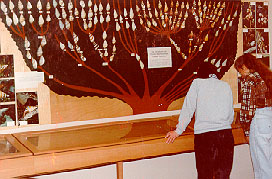 |
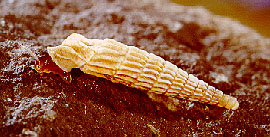 |
left: Albinaria janicollis, 1991 described as a new
species by Schultes and Wiese, living on the island of Gianisáda (NW-Crete) rights Albinaria cretensis rodakinensis, 1990 collected by J. & C. Hemmen in southern Crete and 1991 described as a new subspecies by V. Wiese |
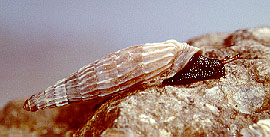 |
One of the world’s largest collection of landsnails from the Greek island of Crete (especially thousands of lots of Clausiliidae, genus Albinaria) make it possible to study the distribution and intra- and interspecific relations of this highly polymorphic genus in a unique way. Dr. F. W. Welter-Schultes (Poster "Life on Earth") (honorarily working at the Haus der Natur - Cismar since 1985; at the moment working at Goettingen university) has done extensive research work in the field and has published numerous important scientific papers on landsnails of Crete. Together with the Albanian scientist Dr. Dhimiter Dhora, F. W. Welter-Schultes also has collected many non-marine molluscs of Albania. A result of this work was a bibliography of the molluscs of Albania containing an atlas with numerous distribution maps on molluscs of this country of which the non-marine molluscs are still quite poorly known.
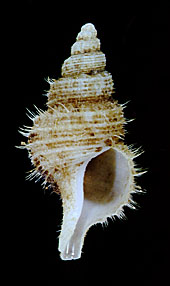 |
Mollusc material collected by research ships during scientific research programs,
especially marine material from arctic regions is studied in the Haus der Natur - Cismar.
The specimens are extensively documented, results of the studies are published. The Haus
der Natur - Cismar is specializing in arctic molluscs. Most research on coldwater molluscs
is done by Dr.Ira
Richling (at the moment working on landsnails at university of Kiel, Germany) and by
Vollrath Wiese. left: Turrisipho dalli from the European Arctic near Bear Island,, METEOR 13/I-13/II #407 |
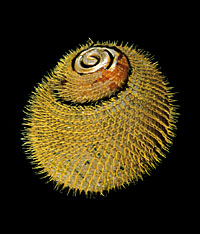 Alviniconcha hessleri from "hot vents" in a depth of 2500 m in the Western Pacific |
Apart from the abovementioned special themes there are many specialized parts of the collection of Haus der Natur - Cismar. A new scientific project for the next years will probably concern marine micromolluscs.
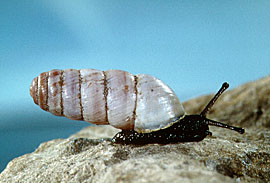 |
Photographic documentation: Photos of living molluscs are taken with special technical effort in order to build up a collection of photographs useful for publications. At the moment most of the photographed molluscs are landsnails. Many specimens of great scientific importance could be photographically documented. left: Cylindrus obtusus, a rare endemic landsnail from the eastern Alps (Austria) |
Haus der Natur - what’s the difference?
This museum interacts with its visitors. You can talk with members of the staff, you can look through glass doors into the management area of the museum, even though the office and scientific library (list of journals) are not always tidied up as you would have done it in your own rooms. You can experience directly how the museum is managed and how the honorary workers are doing their jobs, e.g. when assorting and determining material from research expeditions or when registering the data of molluscs for the documentation collection. In order to be sure that the documentation collection is secure, the rooms with the scientific collection in drawers are not open to the casual visitor. But aside from this minor restriction the Haus der Natur is always open, every day, all day from 10 a.m. to 7 p.m., 365 days a year.
| Appointment? For the casual visitor of Haus der Natur - Cismar an appointment is not necessary. Groups of visitors usually get a guided tour with the option of using our materials for education. An appointment is highly recommended for groups. For those visitors who have special scientific questions or who want some help in the determination of molluscan species, an appointment is absolutely necessary. |
below: 1997 a few aquarium and terrarium containers were built in the Haus der Natur. They mostly contain gastropods, bivalves, and some animals from the brackish waters of the nearby Baltic Sea. Neptunea antiqua lives in the Baltic rarely in depths of 20 m.
|
Many thanks to my friends Jan Richling of Hohen Neuendorf and David Hingston of Hamburg for many helpful suggestions and technical support.
Who's who in the Haus der Natur - Cismar? (in German language)
Welcome to the Haus der Natur - Cismar, daily from 10 a.m to 19
p.m.
info@hausdernatur.de
The Haus der Natur - Cismar pages were visited
times since May 4th, 1998.
The newly created www.mollusca.net
is also managed by Haus der Natur - Cismar.
Thanks to asa-multimedia for ceding www.mollusca.de
(back to Haus der Natur - Cismar - website-index)